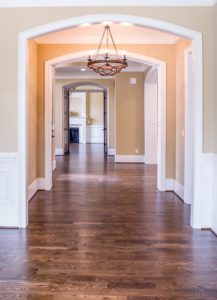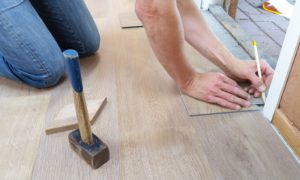Steps to Fix Water Damaged Laminate Flooring

When you originally bought your laminate flooring, you probably purchased it for looks as well as functionality. Most laminate is technically able to withstand occasional spills. Consequently, when you drop a glass of juice, it isn’t going to do any damage to the laminate.
Flooding is a different matter.
When laminate becomes super-saturated with liquid, whether it’s water or water mixed with dirt or sewage, it begins to absorb the moisture. Eventually, this can lead to a whole host of problems. For instance, you might notice that certain laminate planks are buckled. Others could be bent in unusual ways. And as you walk across the floor, some planks could “give” under your footsteps.
These are all dramatic — and unpleasant — indicators that your laminate floor needs to be professionally repaired by someone like an expert from ServiceMaster of Lincoln Park.
In the meantime, you should take some immediate actions to get the process moving and your home back to its pre-flooding condition.
1. Be Sure the Source of the Flood Damage Has Been Fixed
There isn’t any point in rescuing a laminate floor if it’s just going to get wet again. If you haven’t found the source of leaking or flooding, put your laminate flooring repair job on hold until you do. The last thing you want is to completely restore your laminate, only to have it get waterlogged again.
2. Determine Which Laminate Areas Are Destroyed
This shouldn’t be too difficult, but it will take some due diligence and a bit of patience. Systematically give every inch of your laminate flooring a once-over. Push on it, check for bubbles and warping, and be critical in your evaluation.
As you find areas of obvious or not-so-obvious water damage, mark them with a sticky note or some other indicator. That way, you can easily see how far-reaching the issue is, simply by taking a glance at the floor.
3. Pry up Any Damaged Laminate Planks
You’ll need the right tools for this job. If you don’t have them and don’t want to purchase them, you’ll need a professional’s help. If you live in the Chicago area, call ServiceMaster of Lincoln Park for more information and fast service.
If you’re doing this yourself, be careful and safe as you pull up damaged laminate planks. Don’t forget that the baseboard will need to be pried up as well, exposing the bare floor beneath.
Dispose of the laminate flooring as you go to keep clutter from building in the room, and be sure to have good air ventilation, as dust and dirt can “kick up” during the process.
Be sure to note any areas on the bare floor that look as though they have mold. If there is a leak somewhere in your home, these areas could have been moist for weeks or even months, leaving the perfect breeding ground for mold growth.
Mold is a whole different ball game and for the safety of your family, a mold remediation expert should be called right away. ServiceMaster can handle both the water damaged laminate floor and we are certified to tackle any mold issues as well.
4. Replace the Laminate Planks
 This might be the biggest challenge, because unless you purchased extra laminate planks when you had yours originally installed, you could discover that true replacements are difficult to find. Can’t unearth any planks that look like the remaining ones? You might be better off simply replacing the whole floor.
This might be the biggest challenge, because unless you purchased extra laminate planks when you had yours originally installed, you could discover that true replacements are difficult to find. Can’t unearth any planks that look like the remaining ones? You might be better off simply replacing the whole floor.
Do your best to find suitable replacement planks that will blend in nicely. A laminate flooring dealer may be able to help you find something that is an exact or almost-exact match. Just take a piece of the warped laminate in and start the discussion.
Water damaged laminate floors aren’t a fast fix, but they can frequently be repaired without the need to completely buy a whole new floor. If you aren’t sure where to turn for advice, be sure to give our team a call.


Comments are closed.